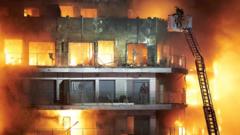According to experts quoted by local media, highly flammable cladding on the building allowed the fire to spread rapidly.
Esther Puchades, who is the vice president of the College of Industrial Technical Engineers of Valencia, tells Spanish news agency Efe that she had previously inspected the building.
The building’s exterior, Puchades explains, featured a polyurethane material that is no longer in wide use due to fears over flammability. It also has an aluminium covering.
“The reason the [building] burned so fast is because of this type of cladding,” she adds.
The cladding has been described by experts as effective for heat insulation but the ventilation, or gap, between it and the covering means it can be highly flammable.
Luis Sendra, of Valencia’s architects’ association, says this can cause a “chimney effect”, allowing fires to spread more quickly.
The issue of flammable cladding gained prominence in the UK after the 2017 Grenfell Tower disaster, in which 72 people died when a tower block in west London caught fire.
